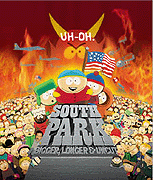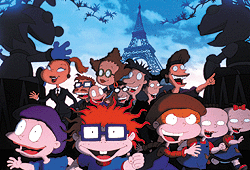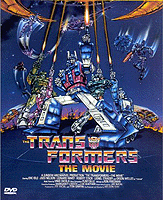The innate pitfalls, and opportunities, in successfully adapting a television show to the big screen are many. With millions in profits going to those who achieve the magic combo, and straight-to-video relegation for those who fail, it is a tight rope more studios are trying to rush across. Gerard Raiti takes a look.

"Bigger, Longer and Uncut." These are the adjectives that subtitled the South Park feature film of 1999. These same adjectives brashly typify the mission statement, the ethos, upheld by animation studios when cartoons transition to the big screen. Then again, you should hope that after paying $5 to $10 for a movie ticket, the film represents something more than what is broadcast every Saturday morning. The innate pitfalls, and opportunities, in bringing a television show to the theaters successfully however are many. With millions in profits going to those who achieve the magic combo, and straight-to-video relegation for those who fail, it is a tight rope more studios are trying to rush across.
A Chance to Shine
When a cartoon like Disney's Recess makes it to the silver screen, it is a global testament to the endearment these characters have garnered in a relatively short period of time. A movie version of a cartoon justifies a show's popularity. On the other hand, it also indicates that the cartoon is edging that much closer to that big movie vault in the sky. Does anyone even watch South Park anymore? Exactly.

Nevertheless, big screen cartoons are genuinely about the fans. True, this tribute to fandom often yields millions in profit dollars for studios if done well, but this is just an unfortunate side effect on which companies have to bite the bullet in chagrin! Think of the cartoon movies you dragged your parents to when you were younger, and then think about, in turn, how many of these movies you have had to sit through with your children or grandchildren. Now, think about how happy they were (and back to how happy you were) to attend the movie. The big screen is an experience, and for children especially, it becomes that much more of an experience when the movie features the world of characters they have spent their Saturday mornings and after-school hours watching. This creates the urgency of why big screen cartoons must be "bigger, longer and uncut" when compared with their small screen counterparts; studios are rewarding fans for devotion.
There are also some tremendous benefits when bringing cartoons to movie-form. While a typical television show is half an hour in length, cinematic versions average around eighty minutes. This added time allows for grander adventures with more complicated plot twists and character development. In the case of Tommy, Chuckie and the other Rugrats, their movie and its sequel allowed them to "boldly go where no baby has gone before!" Coupled with higher budgets that allow for better animation, sound and "celebrity" voice talent, big screen cartoons align all the intrinsic variables to maximize the potential of sending characters on their greatest adventure ever. Above all, the cinematic experience is a draw card in itself. This is why George Lucas chose to re-release the Star Wars Trilogy in 1997 -- not only to make a substantial amount of money but also to give an entirely new generation of Star Wars fans the opportunity to experience the movies on the big screen, the way they were intended to be seen. The hype around big screen versions draws a new crowd and re-invigorates fans that perhaps have strayed.

Staying True to Character
There are, however, risks when transitioning cartoons to the big screen. How do you balance this call for high adventure with a property designed for an 11 or 22 minute venue? Disney's Recess: School's Out creators and writers Paul Germain and Joe Ansolabehere discussed with Animation World some of their first fears regarding the excursion. "When we were asked to [make a Recess movie,] our gut reaction was, 'No, let's not do it.' When we started playing with the idea, we were told it had to be big -- bigger than anything we've ever done before. It couldn't be a big TV show."
While they attribute the move of many small screen wonders to the big screen as a sign of studio commercialism -- "Genuinely we think it's kind of a commercial move on the part of studios...It has to do more with economics and business than art." -- they are advocates that big screen cartoons should maintain the integrity of the original series while taking it to the next level. "[Recess] has always been talking about the world within the microcosm of a playground -- taking small things and treating them as big... School is about more than just cramming information down kids' throats. Recess is where kids learn to interact socially. It's invaluable. We couldn't abandon that for the movie." This is in contrast to The Rugrats Movie, which Paul Germain feels "betrayed the idea of the series." He can justifiably make this comment being one of the co-creators of Rugrats in 1989 for Nickelodeon. "The success of The Rugrats Movie had to do with the success of the series. It betrayed the concept in terms of both animation and story." The televised Rugrats revolves around the "small" events of toddlers' first experiencing the world. Many felt that the first movie strayed too far by putting the children in such frightful situations as being alone in a forest. An adventure to the back of a closet is one thing...an overnight stay in a scary wood while being stalked by a wolf is quite another. This made many parents uneasy.

Ansolabehere continues, "We didn't want [Recess: School's Out] to be a 3-part TV episode. It doesn't have to be the greatest adventure ever, but it's got to be bigger. Our shows are about the small things in life that aren't dealt with these days. If you're in film, it has to be high concept and big, but you have to make something good within the parameters." Germain and Ansolabehere are continuing their beliefs in creating Disney's Lloyd in Space for ABC. It is refreshing to know that they are maintaining the Disney tradition by making good shows, by just doing what they believe in.
Against the Very Nature?
Renewed popularity in The Jetsons and Tom & Jerry in the early '90s led to the production of their respective feature-length films. Both are examples of how not to transfer half-hour icons into ninety-minute farces. However, are the adapters to blame or the general nature of these particular cartoons? Both are historically funny cartoons because the humor of their characters is sustainable within a twenty-minute storyline. But sometimes, when characters are removed from their natural habitat, there is no way they can function optimally. Nevertheless, as pitiful as Tom and Jerry: The Movie was, there is no way Film Roman could have produced ninety minutes of a cat chasing a mouse because there is no way to sustain that humor while staying innately true to the original core of the show.

Catching the Wave
While finding the delicate balance between the show's original emotional center and the demands of the theater is tough, writer/producer Alan Burnett summarizes his foray into big screen toonage very succinctly: "Making movies takes a lot longer." As a writer for Disney's DuckTales: The Movie and Warner Bros.' Batman: Mask of the Phantasm, much pressure was put on him to produce a great story in a limited amount of time because the movies had to be released no later than a year and a half from the conception date. Studios tend to rush the production of big screen cartoons in order to capitalize on a show's popularity before it wanes. "In the case of Batman: MOTP I had my group of story editors, Paul Dini, Martin Pascoe and Michael Reaves, and what I did was write a very detailed treatment so that I could split it up amongst the four of us and get the script out faster...which is unusual."
When producing DuckTales: The Movie, the Disney crew was given such a limited time to create the film that it was not possible to incorporate any songs. "So we had to make a lot more plot than we would have liked. It turned out kind of frenetic. I think it worked better on TV because of the commercials. They broke up the plot so it wasn't one long chase, which is really what the movie was."

In fact, Disney was in such a rush to release a DuckTales movie that the original plan was to take one of the multi-part episodes (i.e., the origins of Bubba Duck or Gizmo Duck) and release it theatrically. "[Disney staff] were going through the episodes seeing what could be a movie," Burnett explains. "When they tried blowing some of them up on a bigger screen the quality of the animation was too poor." This resulted in DuckTales: The Movie as we know it. The big and small screens are very different and those studios that try to create a half-hearted mishmash often fail. So while it is advantageous for studios to rush cartoon features, the result can often lead to sub-par stories and animation.
It Isn't All GravyBatman: MOTP experienced an extremely short theatrical run in late 1993. The movie was released less than sixteen months after Batman: The Animated Series premiered on Fox Kids in 1992. Burnett explains how Warner Bros. had little hope for Batman: MOTP in theatres, for example, in Los Angeles, it was only screened as a matinee, which is extremely atypical in such a large market: "I think part of the problem was the animation. What we were getting back from overseas was not up to par with what we wanted. The movie originally began as a home video, and one of the executives saw some computer animation that was being applied to the movie and decided that it should go into the theatres. It turns out the computer animation was a small part of the animation we were doing. Fortunately, the animation at the climax was good which helped a great deal."

Although Batman: MOTP was not a disaster, it was a signpost to Warner Bros. regarding their philosophy of animated superhero movies. The subsequent Batman animated movie, Batman & Mr. Freeze: Subzero was a direct-to-video release, as was Batman/Superman Movie (a.k.a. World's Finest from the TV series), and Batman Beyond: Return of the Joker. Any of these movies, especially World's Finest, could have made it to the big screen, but Warner Bros. chose the more innocuous route by releasing them to video. "I do think there is a market for superhero or action-adventure animation out there," commented Burnett. "It just takes someone who is willing to spend the money to produce something that is really fun and good looking."
Nudging Along TV
There is also the case of when cartoon movies advance the storylines of their TV shows in an exponential fashion. This can serve as a boost to a show which is becoming stale, or to a writing staff in need of new plots. Case examples of this are The Transformers: The Movie and G. I. Joe: The Movie. Within twenty minutes of The Transformers: The Movie, the two "stars" of the movie, Optimus Prime and Megatron, kill each other in battle. The result of their deaths and the onslaught of new villain Unicron led to a new breed of Autobots and Decepticons, led by Rodimus Prime and Galvatron respectively. This radically altered The Transformers TV series for the remainder of its tenure.

In these tough financial days, studios will be wearier in how they produce these grand, cinematic cartoons. But the Rugrats features, along with the Pokemon movies, Beavis and Butthead Do America, Digimon: The Movie, South Park: Bigger, Longer and Uncut and now Recess: School's Out have all been at least respectable at the box office if not smash hits, which means, of course, that there will be more! The brightest beacon on the horizon looks to be The Powerpuff Girls movie. It will be the first movie produced at Cartoon Network's new studio and is slated for Summer 2002. Once again under the crush of high quality demands and little time, Cartoon Network is taking a gamble that the Girls will still be hot in 2002. If it were released this summer, at what may be the peak of the show's popularity, it would be a guaranteed success...however, what results it yields in 2002, will be determined by the fickle demands of the pre-teen set.
In the meantime, fans can enjoy their favorite shows on television and hope that one day they will be able to experience "the greatest adventure ever!" for that show. As Alan Burnett reminds us, "The primary goal is to cash in. It's a fine goal as far as I'm concerned. The problem is that [studios] want something as quickly as possible. You always want more time to make these films right." Whether animated or from the faster-paced live-action production realm, as Burnett is demonstrating through his involvement in the forthcoming Batman Beyond movie, fans will be waiting, and hoping, that their favorite show is next on the big screen gravy train.
Gerard Raiti, a native of Baltimore currently residing in Nashville, has reported on animation, Broadway musicals and comic books for various publications including Fandomshop.com and Newsweek. He also holds the Diploma of the Royal Schools of Music, U.K. in classical piano and music.







